Ozlem Tugfe Demir
Detecting Multiple Targets with Distributed Sensing and Communication in Cell-Free Massive MIMO
Jul 23, 2025Abstract:This paper investigates multi-target detection in an integrated sensing and communication (ISAC) system within a cell-free massive MIMO (CF-mMIMO) framework. We adopt a user-centric approach for communication user equipments (UEs) and a distributed sensing approach for multi-target detection. A heuristic access point (AP) mode selection algorithm and a channel-aware distributed sensing scheme are proposed, where local measurements at receive APs (RX-APs) are weighted based on the received signals signal-to-interference ratio (SIR). A maximum a posteriori ratio test (MAPRT) detector is applied under two awareness levels at RX-APs. To balance the communication-sensing trade-off, we develop a power allocation algorithm to jointly maximize the minimum detection probability and communication signal-to-interference-plus-noise ratio (SINR) while satisfying power constraints. The proposed scheme outperforms non-weighted methods. Adding test statistics from more RX-APs can degrade sensing performance due to weaker channels, but this effect can be mitigated by optimizing the weighting exponent. Additionally, assigning more sensing RX-APs to a sensing area results in approximately 10 dB loss in minimum communication SINR due to limited communication resources.
Millimeter-Wave Joint Radar and Communications With an RIS-Integrated Array
Apr 13, 2025Abstract:In the context of the joint radar and communications (JRC) framework, reconfigurable intelligent surfaces (RISs) emerged as a promising technology for their ability to shape the propagation environment by adjusting their phase-shift coefficients. However, achieving perfect synchronization and effective collaboration between access points (APs) and RISs is crucial to successful operation. This paper investigates the performance of a bistatic JRC network operating in the millimeter-wave (mmWave) frequency band, where the receiving AP is equipped with an RIS-integrated array. This system simultaneously serves multiple UEs while estimating the position of a target with limited prior knowledge of its position. To achieve this, we optimize both the power allocation of the transmitted waveform and the RIS phase-shift matrix to minimize the position error bound (PEB) of the target. At the same time, we ensure that the UEs achieve an acceptable level of spectral efficiency. The numerical results show that an RIS-integrated array, even with a small number of receiving antennas, can achieve high localization accuracy. Additionally, optimized phase-shifts significantly improve the localization accuracy in comparison to a random phase-shift configuration.
Detecting Unauthorized Drones with Cell-Free Integrated Sensing and Communication
Jan 25, 2025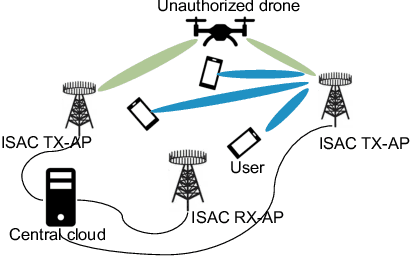
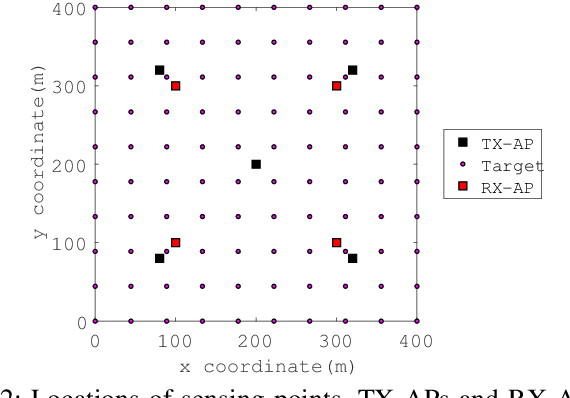

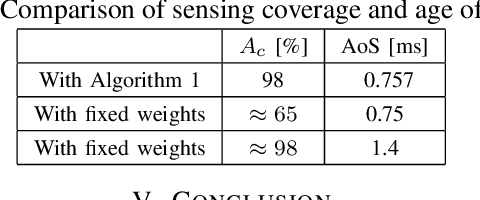
Abstract:Integrated sensing and communication (ISAC) boosts network efficiency by using existing resources for diverse sensing applications. In this work, we propose a cell-free massive MIMO (multiple-input multiple-output)-ISAC framework to detect unauthorized drones while simultaneously ensuring communication requirements. We develop a detector to identify passive aerial targets by analyzing signals from distributed access points (APs). In addition to the precision of the sensing, timeliness of the sensing information is also crucial due to the risk of drones leaving the area before the sensing procedure is finished. We introduce the age of sensing (AoS) and sensing coverage as our sensing performance metrics and propose a joint sensing blocklength and power optimization algorithm to minimize AoS and maximize sensing coverage while meeting communication requirements. Moreover, we propose an adaptive weight selection algorithm based on concave-convex procedure to balance the inherent trade-off between AoS and sensing coverage. Our numerical results show that increasing the communication requirements would significantly reduce both the sensing coverage and the timeliness of the sensing. Furthermore, the proposed adaptive weight selection algorithm can provide high sensing coverage and reduce the AoS by 45% compared to the fixed weights, demonstrating efficient utilization of both power and sensing blocklength.
Parametric Channel Estimation for RIS-Assisted Wideband Systems
Dec 18, 2024Abstract:A reconfigurable intelligent surface (RIS) alters the reflection of incoming signals based on the phase-shift configuration assigned to its elements. This feature can be used to improve the signal strength for user equipments (UEs), expand coverage, and enhance spectral efficiency in wideband communication systems. Having accurate channel state information (CSI) is indispensable to realize the full potential of RIS-aided wideband systems. Unfortunately, CSI is challenging to acquire due to the passive nature of the RIS elements, which cannot perform transmit/receive signal processing. Recently, a parametric maximum likelihood (ML) channel estimator has been developed and demonstrated excellent estimation accuracy. However, this estimator is designed for narrowband systems with no non-line-of-sight (NLOS) paths. In this paper, we develop a novel parametric ML channel estimator for RIS-assisted wideband systems, which can handle line-of-sight (LOS) paths in the base station (BS)-RIS and RIS-UE links as well as NLOS paths between the UE, BS, and RIS. We leverage the reduced subspace representation induced by the array geometry to suppress noise in unused dimensions, enabling accurate estimation of the NLOS paths. Our proposed algorithm demonstrates superior estimation performance for the BS-UE and RIS-UE channels, outperforming the existing ML channel estimator.
Communicate or Sense? AP Mode Selection in mmWave Cell-Free Massive MIMO-ISAC
Dec 03, 2024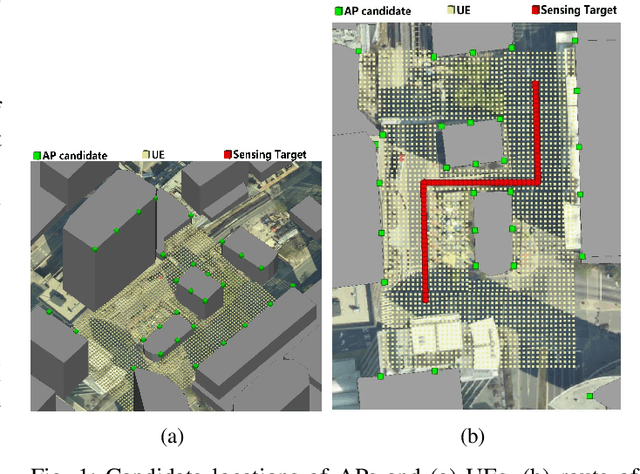
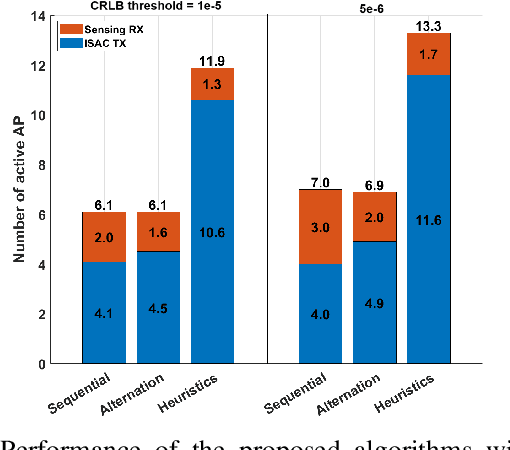

Abstract:Integrated sensing and communication (ISAC) is a promising technology for future mobile networks, enabling sensing applications to be performed by existing communication networks, consequently improving the system efficiency. Millimeter wave (mmWave) signals provide high sensing resolution and high data rate but suffer from sensitivity to blockage. Cell-free massive multiple-input multiple-output (MIMO), with a large number of distributed access points (APs), can overcome this challenge by providing macro diversity against changing blockages and can save energy consumption by deactivating unfavorable APs. Thus, in this work, we propose a joint dynamic AP mode selection and power allocation scheme for mmWave cell-free massive MIMO-ISAC, where APs are assigned either as ISAC transmitters, sensing receivers, or shut down. Due to the large size of the original problem, we propose three different sub-optimal algorithms that minimize the number of active APs while guaranteeing the sensing and communication constraints. Numerical results demonstrate that assigning ISAC transmitters only satisfying communication constraints, followed up by sensing receiver assignment only for sensing constraint achieves the best performance-complexity balance.
Clutter-Aware Target Detection for ISAC in a Millimeter-Wave Cell-Free Massive MIMO System
Nov 13, 2024



Abstract:In this paper, we investigate the performance of an integrated sensing and communication (ISAC) system within a cell-free massive multiple-input multiple-output (MIMO) system. Each access point (AP) operates in the millimeter-wave (mmWave) frequency band. The APs jointly serve the user equipments (UEs) in the downlink while simultaneously detecting a target through dedicated sensing beams, which are directed toward a reconfigurable intelligent surface (RIS). Although the AP-RIS, RIS-target, and AP-target channels have both line-of-sight (LoS) and non-line-of-sight (NLoS) parts, it is assumed only knowledge of the LoS paths is available. A key contribution of this study is the consideration of clutter, which degrades the target detection if not handled. We propose an algorithm to alternatively optimize the transmit power allocation and the RIS phase-shift matrix, maximizing the target signal-to-clutter-plus-noise ratio (SCNR) while ensuring a minimum signal-to-interference-plus-noise ratio (SINR) for the UEs. Numerical results demonstrate that exploiting clutter subspace significantly enhances detection probability, particularly at high clutter-to-noise ratios, and reveal that an increased number of transmit side clusters impair detection performance. Finally, we highlight the performance gains achieved using a dedicated sensing stream.
Destructive and constructive RIS beamforming in an ISAC-multi-user MIMO network
Apr 17, 2024



Abstract:Integrated sensing and communication (ISAC) has already established itself as a promising solution to the spectrum scarcity problem, even more so when paired with a reconfigurable intelligent surface (RIS) as RISs can shape the propagation environment by adjusting their phase-shift coefficients. Albeit the potential performance gain, a RIS also poses a security threat to the system: in this paper, we explore both sides of the RIS presence in a multi-user MIMO (multiple-input multiple-output) ISAC network. We first develop an alternating optimization algorithm, obtaining the active and passive beamforming vectors maximizing the sensing signal-to-noise ratio (SNR) under minimum signal-to-interference-plus-noise ratio (SINR) constraints for the communication users and finite power budget. We also investigate the destructive potential of RIS by devising a RIS phase-shift optimization algorithm that minimizes sensing SNR while preserving the same minimum communication SINR previously guaranteed by the system. We further investigate the impact of the RIS's individual element failures on the system performances. The simulation results show that the RIS performance-boosting potential is as good as its destructive one and that both of our optimization strategies show some resilience towards the investigated impairments.
Malicious Reconfigurable Intelligent Surfaces: How Impactful can Destructive Beamforming be?
Feb 20, 2024


Abstract:Reconfigurable intelligent surfaces (RISs) have demonstrated significant potential for enhancing communication system performance if properly configured. However, a RIS might also pose a risk to the network security. In this letter, we explore the impact of a malicious RIS on a multi-user multiple-input single-output (MISO) system when the system is unaware of the RIS's malicious intentions. The objective of the malicious RIS is to degrade the \ac{SNR} of a specific \ac{UE}, with the option of preserving the SNR of the other UEs, making the attack harder to detect. To achieve this goal, we derive the optimal RIS phase-shift pattern, assuming perfect channel state information (CSI) at the hacker. We then relax this assumption by introducing CSI uncertainties and subsequently determine the RIS's phase-shift pattern using a robust optimization approach. Our simulations reveal a direct proportionality between the performance degradation caused by the malicious RIS and the number of reflective elements, along with resilience toward CSI uncertainties.
 Add to Chrome
Add to Chrome Add to Firefox
Add to Firefox Add to Edge
Add to Edge